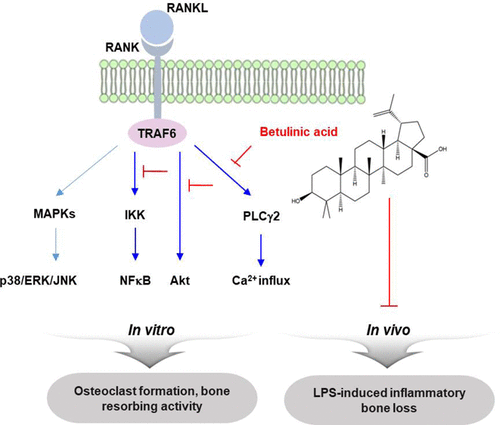当前位置:
X-MOL 学术
›
J. Nat. Prod.
›
论文详情
Our official English website, www.x-mol.net, welcomes your
feedback! (Note: you will need to create a separate account there.)
Betulinic Acid Inhibits RANKL-Induced Osteoclastogenesis via Attenuating Akt, NF-κB, and PLCγ2-Ca2+ Signaling and Prevents Inflammatory Bone Loss.
Journal of Natural Products ( IF 3.3 ) Pub Date : 2020-04-02 , DOI: 10.1021/acs.jnatprod.9b01212 Da Hye Jeong 1 , Sung Chul Kwak 2 , Myeung Su Lee 1, 3 , Kwon-Ha Yoon 4, 5 , Ju-Young Kim 3, 5 , Chang Hoon Lee 1, 5
Journal of Natural Products ( IF 3.3 ) Pub Date : 2020-04-02 , DOI: 10.1021/acs.jnatprod.9b01212 Da Hye Jeong 1 , Sung Chul Kwak 2 , Myeung Su Lee 1, 3 , Kwon-Ha Yoon 4, 5 , Ju-Young Kim 3, 5 , Chang Hoon Lee 1, 5
Affiliation

|
The increase of bone-resorbing osteoclast activity in bone remodeling is the major characteristic of various bone diseases. Thus, inhibiting osteoclastogenesis and bone-resorbing function may be an effective therapeutic target for bone diseases. Betulinic acid (BA), a natural plant-derived pentacyclic triterpenoid compound, is known to possess numerous pharmacological and biochemical properties including anti-inflammatory, anticancer, and antiadipogenic activity. However, the effect of BA on osteoclast differentiation and function in bone metabolism has not been demonstrated so far. In this study, we investigated whether BA could suppress RANKL-induced osteoclastogenesis and bone resorption. Interestingly, BA significantly suppressed osteoclastogenesis by decreasing the phosphorylation of Akt and IκB, as well as PLCγ2-Ca2+ signaling, in pathways involved in early osteoclastogenesis as well as through the subsequent suppression of c-Fos and NFATc1. The inhibition of these pathways by BA was once more confirmed by retrovirus infection of constitutively active (CA)-Akt and CA-Ikkβ retrovirus and measurement of Ca2+ influx. BA also significantly inhibited the expression of osteoclastogenesis-specific marker genes. Moreover, we found that BA administration restored the bone loss induced through acute lipopolysaccharide injection in mice by a micro-CT and histological analysis. Our findings suggest that BA is a potential therapeutic candidate for bone diseases involving osteoclasts.
中文翻译:

Betulinic Acid通过减弱Akt,NF-κB和PLCγ2-Ca2+信号传导抑制RANKL诱导的破骨细胞生成,并防止炎症性骨丢失。
骨重塑中骨吸收破骨细胞活性的增加是各种骨疾病的主要特征。因此,抑制破骨细胞生成和骨吸收功能可能是骨疾病的有效治疗靶标。桦木酸(BA)是一种天然植物来源的五环三萜类化合物,已知具有许多药理和生化特性,包括抗炎,抗癌和抗脂肪形成活性。然而,到目前为止,尚未证明BA对破骨细胞分化和骨代谢功能的影响。在这项研究中,我们调查了BA是否可以抑制RANKL诱导的破骨细胞生成和骨吸收。有趣的是,BA通过降低Akt和IκB的磷酸化以及PLCγ2-Ca2+信号转导来显着抑制破骨细胞生成,参与早期破骨细胞形成以及随后抑制c-Fos和NFATc1的途径。逆转录病毒感染组成性活性(CA)-Akt和CA-Ikkβ逆转录病毒并测量Ca2 +流入再次证实了BA对这些途径的抑制作用。BA还显着抑制破骨细胞生成特异性标记基因的表达。此外,我们发现通过微CT和组织学分析,BA给药可恢复小鼠急性脂多糖注射引起的骨丢失。我们的发现表明,BA是涉及破骨细胞的骨病的潜在治疗候选物。逆转录病毒感染组成性活性(CA)-Akt和CA-Ikkβ逆转录病毒并测量Ca2 +流入再次证实了BA对这些途径的抑制作用。BA还显着抑制破骨细胞生成特异性标记基因的表达。此外,我们发现通过微CT和组织学分析,BA给药可恢复小鼠急性脂多糖注射引起的骨丢失。我们的发现表明,BA是涉及破骨细胞的骨病的潜在治疗候选物。逆转录病毒感染组成性活性(CA)-Akt和CA-Ikkβ逆转录病毒并测量Ca2 +流入再次证实了BA对这些途径的抑制作用。BA还显着抑制破骨细胞生成特异性标记基因的表达。此外,我们发现通过微CT和组织学分析,BA给药可恢复小鼠急性脂多糖注射引起的骨丢失。我们的发现表明,BA是涉及破骨细胞的骨病的潜在治疗候选物。我们发现,通过微CT和组织学分析,BA给药可恢复小鼠急性脂多糖注射引起的骨丢失。我们的发现表明,BA是涉及破骨细胞的骨病的潜在治疗候选物。我们发现,通过微CT和组织学分析,BA给药可恢复小鼠急性脂多糖注射引起的骨丢失。我们的发现表明,BA是涉及破骨细胞的骨病的潜在治疗候选物。
更新日期:2020-04-02
中文翻译:

Betulinic Acid通过减弱Akt,NF-κB和PLCγ2-Ca2+信号传导抑制RANKL诱导的破骨细胞生成,并防止炎症性骨丢失。
骨重塑中骨吸收破骨细胞活性的增加是各种骨疾病的主要特征。因此,抑制破骨细胞生成和骨吸收功能可能是骨疾病的有效治疗靶标。桦木酸(BA)是一种天然植物来源的五环三萜类化合物,已知具有许多药理和生化特性,包括抗炎,抗癌和抗脂肪形成活性。然而,到目前为止,尚未证明BA对破骨细胞分化和骨代谢功能的影响。在这项研究中,我们调查了BA是否可以抑制RANKL诱导的破骨细胞生成和骨吸收。有趣的是,BA通过降低Akt和IκB的磷酸化以及PLCγ2-Ca2+信号转导来显着抑制破骨细胞生成,参与早期破骨细胞形成以及随后抑制c-Fos和NFATc1的途径。逆转录病毒感染组成性活性(CA)-Akt和CA-Ikkβ逆转录病毒并测量Ca2 +流入再次证实了BA对这些途径的抑制作用。BA还显着抑制破骨细胞生成特异性标记基因的表达。此外,我们发现通过微CT和组织学分析,BA给药可恢复小鼠急性脂多糖注射引起的骨丢失。我们的发现表明,BA是涉及破骨细胞的骨病的潜在治疗候选物。逆转录病毒感染组成性活性(CA)-Akt和CA-Ikkβ逆转录病毒并测量Ca2 +流入再次证实了BA对这些途径的抑制作用。BA还显着抑制破骨细胞生成特异性标记基因的表达。此外,我们发现通过微CT和组织学分析,BA给药可恢复小鼠急性脂多糖注射引起的骨丢失。我们的发现表明,BA是涉及破骨细胞的骨病的潜在治疗候选物。逆转录病毒感染组成性活性(CA)-Akt和CA-Ikkβ逆转录病毒并测量Ca2 +流入再次证实了BA对这些途径的抑制作用。BA还显着抑制破骨细胞生成特异性标记基因的表达。此外,我们发现通过微CT和组织学分析,BA给药可恢复小鼠急性脂多糖注射引起的骨丢失。我们的发现表明,BA是涉及破骨细胞的骨病的潜在治疗候选物。我们发现,通过微CT和组织学分析,BA给药可恢复小鼠急性脂多糖注射引起的骨丢失。我们的发现表明,BA是涉及破骨细胞的骨病的潜在治疗候选物。我们发现,通过微CT和组织学分析,BA给药可恢复小鼠急性脂多糖注射引起的骨丢失。我们的发现表明,BA是涉及破骨细胞的骨病的潜在治疗候选物。











































 京公网安备 11010802027423号
京公网安备 11010802027423号